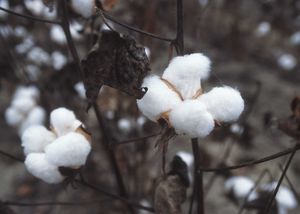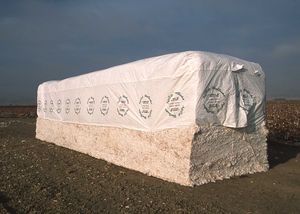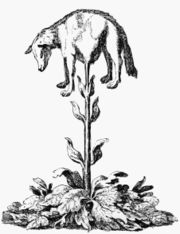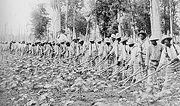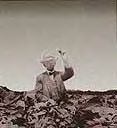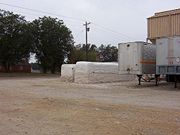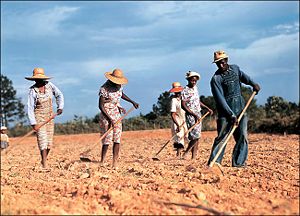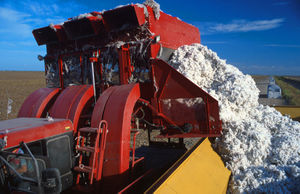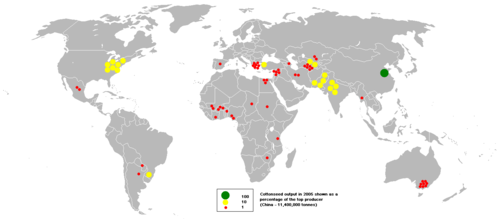Cotton
2008/9 Schools Wikipedia Selection. Related subjects: Plants

Cotton is a soft, staple fibre that grows around the seeds of the cotton plant ( Gossypium sp.), a shrub native to tropical and subtropical regions around the world, including the Americas, India and Africa. The fibre most often is spun into yarn or thread and used to make a soft, breathable textile, which is the most widely used natural-fibre cloth in clothing today. The English name which began to be used circa 1400, derives from the Arabic (al) qutn قُطْن, meaning cotton. In the 19th and early 20th centuries, cotton was known as "King Cotton" because of the great economic and cultural influence it had over the Southern United States.
Cotton fibre, once it has been processed to remove seeds (ginning) and traces of honeydew (a secretion from aphids), protein, vegetable matter, and other impurities, consists of nearly pure cellulose, a natural polymer. Cotton production is very efficient, in the sense that only ten percent or less of the weight is lost in subsequent processing to convert the raw cotton bolls (seed cases) into pure fiber. The cellulose is arranged in a way that gives cotton fibers a high degree of strength, durability, and absorbency. Each fibre is made up of twenty to thirty layers of cellulose coiled in a neat series of natural springs. When the cotton boll is opened, the fibers dry into flat, twisted, ribbon-like shapes and become kinked together and interlocked. This interlocked form is ideal for spinning into a fine yarn.
History
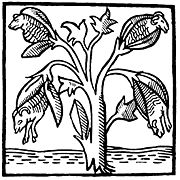
Evidence of the use of cotton in the form of thread has been found in India/Pakistan, dating to about 6,000 B.C., although it is not clear whether the thread derived from cultivation or from wild cotton. Cultivation was underway by the time of the Harappan civilization (now located in Pakistan), which was exporting cotton to Mesopotamia during the 3rd millennium BC. Cotton was soon known to the Egyptians (although linen was their primary fibre source) as well as becoming a prized trading item from Nubia and Meroë. The famous Greek historian Herodotus also wrote about Indian cotton: "There are trees which grow wild there, the fruit of which is a wool exceeding in beauty and goodness that of sheep. The Indians make their clothes of this tree wool." (Book III. 106)
According to The Columbia Encyclopedia, Sixth Edition:
"Cotton has been spun, woven, and dyed since prehistoric times. It clothed the people of ancient India, Egypt, and China. Hundreds of years before the Christian era cotton textiles were woven in India with matchless skill, and their use spread to the Mediterranean countries. In the 1st cent. Arab traders brought fine muslin and calico to Italy and Spain. The Moors introduced the cultivation of cotton into Spain in the 9th cent. Fustians and dimities were woven there and in the 14th cent. in Venice and Milan, at first with a linen warp. Little cotton cloth was imported to England before the 15th cent., although small amounts were obtained chiefly for candlewicks. By the 17th cent. the East India Company was bringing rare fabrics from India. Native Americans skillfully spun and wove cotton into fine garments and dyed tapestries. Cotton fabrics found in Peruvian tombs are said to belong to a pre-Inca culture. In colour and texture the ancient Peruvian and Mexican textiles resemble those found in Egyptian tombs."
The earliest cultivation of cotton discovered thus far in the Americas occurred in Mexico, some 5,000 years ago. The indigenous species was Gossypium hirsutum which is today the most widely planted species of cotton in the world, constituting about 90% of all production worldwide. The greatest diversity of wild cotton species is found in Mexico, followed by Australia and Africa.
In Peru, cultivation of the indigenous cotton species Gossypium barbadense was the backbone of the development of coastal cultures such as the Norte Chico, Moche and Nazca. Cotton was grown upriver, made into nets and traded with fishing villages along the coast for large supplies of fish. The Spanish who came to Mexico in the early 1500s found the people growing cotton and wearing clothing made of it.
During the late medieval period, cotton became known as an imported fibre in northern Europe, without any knowledge of how it was derived, other than that it was a plant; noting its similarities to wool, people in the region could only imagine that cotton must be produced by plant-borne sheep. John Mandeville, writing in 1350, stated as fact the now-preposterous belief: "There grew there [India] a wonderful tree which bore tiny lambs on the endes of its branches. These branches were so pliable that they bent down to allow the lambs to feed when they are hungrie." (See Vegetable Lamb of Tartary.) This aspect is retained in the name for cotton in many European languages, such as German Baumwolle, which translates as "tree wool" (Baum means "tree"; Wolle means "wool"). By the end of the 16th century, cotton was cultivated throughout the warmer regions in Asia and the Americas.
India's cotton-processing sector gradually declined during British expansion in India and the establishment of colonial rule during the late 18th and early 19th centuries. This was largely due to the East India Company's de-industrialization of India, which forced the closing of cotton processing and manufacturing workshops in India, to ensure that Indian markets supplied only raw materials and were obliged to purchase manufactured textiles from Britain.
The advent of the Industrial Revolution in Britain provided a great boost to cotton manufacture, as textiles emerged as Britain's leading export. In 1738 Lewis Paul and John Wyatt, of Birmingham England, patented the Roller Spinning machine, and the flyer-and-bobbin system for drawing cotton to a more even thickness using two sets of rollers that traveled at different speeds. Later, the invention of the spinning jenny in 1764 and Richard Arkwright's spinning frame (based on the Roller Spinning Machine) in 1769 enabled British weavers to produce cotton yarn and cloth at much higher rates. From the late eighteenth century onwards, the British city of Manchester acquired the nickname " cottonopolis" due to the cotton industry's omnipresence within the city, and Manchester's role as the heart of the global cotton trade. Production capacity was further improved by the invention of the cotton gin by Eli Whitney in 1793. Improving technology and increasing control of world markets allowed British traders to develop a commercial chain in which raw cotton fibers were (at first) purchased from colonial plantations, processed into cotton cloth in the mills of Lancashire, and then re-exported on British ships to captive colonial markets in West Africa, India, and China (via Shanghai and Hong Kong).
By the 1840s, India was no longer capable of supplying the vast quantities of cotton fibers needed by mechanised British factories, while shipping bulky, low-price cotton from India to Britain was time-consuming and expensive. This, coupled with the emergence of American cotton as a superior type (due to the longer, stronger fibers of the two domesticated native American species, Gossypium hirsutum and Gossypium barbadense), encouraged British traders to purchase cotton from plantations in the United States and the Caribbean. This was also much cheaper as it was produced by unpaid slaves. By the mid 19th century, " King Cotton" had become the backbone of the southern American economy. In the United States, cultivating and harvesting cotton became the leading occupation of slaves.
During the American Civil War, American cotton exports slumped due to a Union blockade on Southern ports, also because of a strategic decision by the Confederate Government to cut exports, hoping to force Britain to recognize the Confederacy or enter the war, prompting the main purchasers of cotton, Britain and France, to turn to Egyptian cotton. British and French traders invested heavily in cotton plantations and the Egyptian government of Viceroy Isma'il took out substantial loans from European bankers and stock exchanges. After the American Civil War ended in 1865, British and French traders abandoned Egyptian cotton and returned to cheap American exports, sending Egypt into a deficit spiral that led to the country declaring bankruptcy in 1876, a key factor behind Egypt's annexation by the British Empire in 1882.
During this time cotton cultivation in the British Empire, especially India, greatly increased to replace the lost production of the American South. Through tariffs and other restrictions the British government discouraged the production of cotton cloth in India; rather the raw fibre was sent to England for processing. The Indian patriot Mahatma Gandhi described the process:
- English people buy Indian cotton in the field, picked by Indian labor at seven cents a day, through an optional monopoly.
- This cotton is shipped on British bottoms, a three-week journey across the Indian Ocean, down the Red Sea, across the Mediterranean, through Gibraltar, across the Bay of Biscay and the Atlantic Ocean to London. One hundred per cent profit on this freight is regarded as small.
- The cotton is turned into cloth in Lancashire. You pay shilling wages instead of Indian pennies to your workers. The English worker not only has the advantage of better wages, but the steel companies of England get the profit of building the factories and machines. Wages; profits; all these are spent in England.
- The finished product is sent back to India at European shipping rates, once again on British ships. The captains, officers, sailors of these ships, whose wages must be paid, are English. The only Indians who profit are a few lascars who do the dirty work on the boats for a few cents a day.
- The cloth is finally sold back to the kings and landlords of India who got the money to buy this expensive cloth out of the poor peasants of India who worked at seven cents a day. (Fisher 1932 pp 154-156)
In the United States, Southern cotton provided capital for the continuing development of the North. The cotton produced by enslaved African Americans, not only helped the South, but also enriched northern merchants. Much of the southern cotton were transhipped through the northern ports. Profits from the cotton shipping provided some of the funds for the Francis Cabot Lowell's Lowell Mills. In another example, a merchant named Anson Phelps invested his profits from cotton shipping into iron mines in Pennsylvania and metalworks in Connecticut. Much of the development of northern industry was made possible by the cotton provided by the enslaved African Americans of the South. It also fostered the market revolution.
Cotton remained a key crop in the southern economy after emancipation and the end of the civil war in 1865. Across the South, sharecropping evolved, in which free black farmers worked on white-owned cotton plantations in return for a share of the profits. Cotton plantations required vast labor forces to hand-pick cotton fibers, and it was not until the 1950s that reliable harvesting machinery was introduced into the South (prior to this, cotton-harvesting machinery had been too clumsy to pick cotton without shredding the fibers). During the early twentieth century, employment in the cotton industry fell as machines began to replace laborers, and as the South's rural labor force dwindled during the First and Second World Wars. Today, cotton remains a major export of the southern United States, and a majority of the world's annual cotton crop is of the long-staple American variety.
Tangüis cotton
In 1901, Peru's cotton industry suffered because of a fungus plague caused by a plant disease known as "Cotton wilt" and " "Fusarium wilt" ( Fusarium vasinfectum). The plant disease, which spread throughout Peru, entered the plant by its roots and worked it's way up the stem until the plant was completely dried up. Fermín Tangüis a Puerto Rican agriculturist who lived in Peru, studied some speices of the plant that were affected by the disease to a lesser extent and experimented in germination with the seeds of various cotton plants. In 1911, after 10 years of experimenting and failures, Tangüis was able to develop a seed which produced a superior cotton plant resistant to the disease. The seeds produced a plant that had a 40% longer (between 29 mm and 33 mm) and thicker fibre that did not break easily and required little water. The Tanguis cotton, as it bcame known, is the variety which is preferred by the Peruvian national textile industry. It constituted 75 percent of all the Peruvian cotton production, both for domestic use and apparel exports. The Tanguis cotton crop was estimated at 225,000 bales that year.
Cultivation
Successful cultivation of cotton requires a long frost-free period, plenty of sunshine, and a moderate rainfall, usually from 600 to 1200mm (24 to 48 inches). Soils usually need to be fairly heavy, although the level of nutrients does not need to be exceptional. In general, these conditions are met within the seasonally dry tropics and subtropics in the Northern and Southern hemispheres, but a large proportion of the cotton grown today is cultivated in areas with less rainfall that obtain the water from irrigation. Production of the crop for a given year usually starts soon after harvesting the preceding autumn. Planting time in spring in the Northern hemisphere varies from the beginning of February to the beginning of June. The area of the United States known as the South Plains is the largest contiguous cotton-growing region in the world. It is heavily dependent on irrigation water drawn from the Ogallala Aquifer.
Cotton is a thirsty crop, and as water resources get tighter around the world, economies that rely on it face difficulties and conflict, as well as potential environmental problems. For example, cotton has led to desertification in areas of Uzbekistan, where it is a major export. In the days of the Soviet Union, the Aral Sea was tapped for agricultural irrigation, largely of cotton, and now salination is widespread.
Genetically modified cotton
Genetically modified (GM) cotton was developed to reduce the heavy reliance on pesticides. Genetically modified cotton is widely used throughout the world with claims of requiring up to 80% less pesticide than ordinary cotton as typically grown commercially. However, researchers have recently published the first documented case of in-field pest resistance to GM cotton. The International Service for the Acquisition of Agri-Biotech Applications (ISAAA) said that, worldwide, GM cotton was planted on an area of 67,000 km² in 2002. This is 20% of the worldwide total area planted in cotton. The U.S. cotton crop was 73% GM in 2003.
The initial introduction of GM cotton proved to be a commercial and ecological disaster in Australia - the yields were far lower than predicted, and the cotton plants were cross-pollinated with other varieties of cotton. However, the introduction of a second variety of GM cotton led to 15% of Australian cotton being GM in 2003. 80% of the crop was genetically modified in 2004, when the original GM variety was banned.
GM cotton acreage in India continues to grow at a rapid rate increasing from 50,000 hectares in 2002 to 3.8 million hectares in 2006. The total cotton area in India is about 9.0 million hectares (the largest in the world or, about 25% of world cotton area) so GM cotton is now grown on 42% of the cotton area. This makes India the country with the largest area of GM cotton in the world, surpassing China (3.5 million hectares in 2006). The major reasons for this increase is a combination of increased farm income ($225/ha) and a reduction in pesticide use to control the Cotton Bollworm.
Cotton has gossypol, a toxin that makes it inedible. However, scientists have silenced the gene that produces the toxin, making in a potential food crop.
Organic cotton
Organic cotton is cotton that is grown without insecticide or pesticide. Worldwide, cotton is a pesticide-intensive crop, using approximately 25% of the world's insecticides and 10% of the world's pesticides. According to the World Health Organisation (WHO), 20,000 deaths occur each year from pesticide poisoning in developing countries, many of these from cotton farming. Organic agriculture uses methods that are ecological, economical, and socially sustainable and denies the use of agrochemicals and artificial fertilizers. Instead, organic agriculture uses crop rotation, the growing of different crops than cotton in alternative years. The use of insecticides is prohibited; organic agriculture uses natural enemies to suppress harmful insects. The production of organic cotton is more expensive than the production of conventional cotton. Although toxic pollution from synthetic chemicals is eliminated, other pollution-like problems may remain, particularly run-off. Organic cotton is produced in organic agricultural systems that produce food and fibre according to clearly established standards. Organic agriculture prohibits the use of toxic and persistent chemical pesticides and fertilizers, as well as genetically modified organisms. It seeks to build biologically diverse agricultural systems, replenish and maintain soil fertility, and promote a healthy environment.
Pests and weeds
The cotton industry relies heavily on chemicals such as fertilizers and insecticides, although a very small number of farmers are moving toward an organic model of production and organic cotton products are now available for purchase at limited locations. These are popular for baby clothes and diapers. Under most definitions, organic products do not use genetic engineering.
Historically, in North America, one of the most economically destructive pests in cotton production has been the boll weevil. Due to the US Department of Agriculture's highly successful Boll Weevil Eradication Program (BWEP), this pest has been eliminated from cotton in most of the United States. This program, along with the introduction of genetically engineered " Bt cotton" (which contains a bacteria gene that codes for a plant-produced protein that is toxic to a number of pests such as tobacco budworm, cotton bollworm, and pink bollworm), has allowed a reduction in the use of synthetic insecticides.
Mechanized harvesting
Most cotton in the United States, Europe, and Australia is harvested mechanically, either by a cotton picker, a machine that removes the cotton from the boll without damaging the cotton plant, or by a cotton stripper, which strips the entire boll off the plant. Cotton strippers are used in regions where it is too windy to grow picker varieties of cotton, and usually after application of a chemical defoliant or the natural defoliation that occurs after a freeze. Cotton is a perennial crop in the tropics and without defoliation or freezing, the plant will continue to grow.
Cotton continues to be picked by hand in developing countries such as Uzbekistan.
Competition from synthetic fibers
The era of manufactured fibers began with the development of rayon in France in the 1890s. Rayon is derived from a natural cellulose and can not be considered synthetic, but is requires extensive processing in a manufacturing process and led the less expensive replacement of more naturally derived materials. A succession of new synthetic fibers were introduced by the chemicals industry in the following decades. Acetate in fibre form was developed in 1924. Nylon the first fibre synthesized entirely from petrochemicals, was introduced as a sewing thread by DuPont in 1936, followed by Dupont's acrylic in 1944. Some garments were created from fabrics based on these fibers, such as women's hosiery from nylon, but it was not until the introduction of polyester into the fibre marketplace in the early 1950s that the market for cotton came under threat. The rapid uptake of polyester garments in the 1960s caused economic hardship in cotton exporting economies, especially in Central American countries such as Nicaragua where cotton production had boomed tenfold between 1950 and 1965 with the advent of cheap chemical pesticides. Cotton production recovered in the 1970s, but crashed to pre-1960 levels in the early 1990s.
Beginning as a self-help program in the mid-1960s, the Cotton Research & Promotion Program was organized by U.S. cotton producers in response to cotton's steady decline in market share. At that time, producers voted to set up a per-bale assessment system to fund the program, with built-in safeguards to protect their investments. With the passage of the Cotton Research & Promotion Act of 1966, the program joined forces and began battling synthetic competitors and re-establishing markets for cotton. Today, the success of this program has made cotton the best-selling fibre in the U.S. and one of the best-selling fibers in the world.
Administered by the Cotton Board and conducted by Cotton Incorporated, the Cotton Research & Promotion Program works to greatly increase the demand for and profitability of cotton through various research and promotion activities. It is funded by U.S. cotton producers and importers.
Uses
Cotton is used to make a number of textile products. These include terrycloth, used to make highly absorbent bath towels and robes; denim, used to make blue jeans; chambray, popularly used in the manufacture of blue work shirts (from which we get the term " blue-collar"); and corduroy, seersucker, and cotton twill. Socks, underwear, and most T-shirts are made from cotton. Bed sheets often are made from cotton. Cotton also is used to make yarn used in crochet and knitting. Fabric also can be made from recycled or recovered cotton that otherwise would be thrown away during the spinning, weaving, or cutting process. While many fabrics are made completely of cotton, some materials blend cotton with other fibers, including rayon and synthetic fibers such as polyester.
In addition to the textile industry, cotton is used in fishnets, coffee filters, tents, gunpowder (see Nitrocellulose), cotton paper, and in bookbinding. The first Chinese paper was made of cotton fibre. Fire hoses were once made of cotton.
The cottonseed which remains after the cotton is ginned is used to produce cottonseed oil, which, after refining, can be consumed by humans like any other vegetable oil. The cottonseed meal that is left generally is fed to livestock. During slavery, cotton root bark was used as an abortifacient, that is, a folk remedy to provoke abortion.
Cotton linters are fine, silky fibers which adhere to the seeds of the cotton plant after ginning. These curly fibers typically are less than 1/8 in (3 mm) long. The term also may apply to the longer textile fibre staple lint as well as the shorter fuzzy fibers from some upland species. Linters are traditionally used in the manufacture of paper and as a raw material in the manufacture of cellulose.
Shiny cotton is a processed version of the fibre that can be made into cloth resembling satin for shirts and suits. However, its hydrophobic property of not easily taking up water makes it unfit for the purpose of bath and dish towels (although examples of these made from shiny cotton are seen).
The term Egyptian cotton refers to the extra long staple cotton grown in Egypt and favored for the luxury and upmarket brands worldwide. During the U.S. Civil War, with heavy European investments, Egyptian-grown cotton became a major alternate source for British textile mills. Egyptian cotton is more durable and softer than American Pima cotton, which is why it is more expensive. Pima cotton is American cotton that is grown in the south western states of the U.S.
In South Asia, cotton is widely used in mattresses, which are the most common type of mattress used in that region.
The international cotton trade
The United States, with sales of $4.9 billion, and Africa, with sales of $2.1 billion, are the largest exporters of raw cotton. Total international trade is $12 billion. Africa's share of the cotton trade has doubled since 1980. Neither area has a significant domestic textile industry, textile manufacturing having moved to developing nations in Eastern and South Asia such as India and China. In Africa cotton is grown by numerous small holders. Dunavant Enterprises, based in Memphis, Tennessee, is the leading cotton broker in Africa with hundreds of purchasing agents. It operates cotton gins in Uganda, Mozambique, and Zambia. In Zambia it often offers loans for seed and expenses to the 180,000 small farmers who grow cotton for it, as well as advice on farming methods. Cargill also purchases cotton in Africa for export.
The 25,000 cotton growers in the United States are heavily subsidized at the rate of $2 billion per year. The future of these subsidies is uncertain and has led to anticipatory expansion of cotton brokers' operations in Africa. Dunavant expanded in Africa by buying out local operations. This is only possible in former British colonies and Mozambique; former French colonies continue to maintain tight monopolies, inherited from their former colonialist masters, on cotton purchases at low fixed prices.
Leading cotton-producing countries
| Top ten cotton producers — 2007 (million 480-pound bales) |
|
|---|---|
| 35.8 | |
| 25.3 | |
| 19.2 | |
| 9.0 | |
| 7.2 | |
| 5.5 | |
| 3.2 | |
| 1.4 | |
| 1.3 | |
| 1.2 | |
| Source: | |
The five leading exporters of cotton are (1) the United States, (2) Uzbekistan, (3) India, (4) Brazil, and (5) Burkina Faso. The largest non-producing importers are Bangladesh, Indonesia, Thailand, Russia, and Taiwan.
In India, the states of Maharashtra (26.63%), Gujarat (17.96%) and Andhra Pradesh (13.75%) are the leading cotton producing states, these states have a predominantly tropical wet and dry climate.
In the United States, the state of Texas leads in total production while the state of California has the highest yield per acre in the world.
Fair trade
Cotton is an enormously important commodity throughout the world. However, many farmers in developing countries receive a low price for their produce, or find it difficult to compete with developed countries.
This has led to an international dispute:
On 27 September 2002 Brazil requested consultations with the US regarding prohibited and actionable subsidies provided to US producers, users and/or exporters of upland cotton, as well as legislation, regulations, statutory instruments and amendments thereto providing such subsidies (including export credits), grants, and any other assistance to the US producers, users and exporters of upland cotton.
On 8 September 2004, the Panel Report recommended that the United States "withdraw" export credit guarantees and payments to domestic user and exporters, and "take appropriate steps to remove the adverse effects or withdraw" the mandatory price-contingent subsidy measures.
In addition to concerns over subsidies, the cotton industries of some countries are criticized for employing child labor and damaging workers' health by exposure to pesticides used in production. For example, cotton production in Uzbekistan has been described as one of the most exploitative industries in the world. The international production and trade situation has led to ' fair trade' cotton clothing and footwear, joining a rapidly growing market for organic clothing, fair fashion or so-called 'ethical fashion'. The fair trade system was initiated in 2005 with producers from Cameroon, Mali and Senegal.
Critical temperatures
- Favorable travel temperature range - no lower limit: 25 °C (77 °F)
- Optimum travel temperature: 20 °C (68 °F)
- Glow temperature: 205 °C (401 °F)
- Fire point: 210 °C (410 °F)
- Autoignition temperature: 407 °C (765 °F)
- Autoignition temperature (for oily cotton): 120 °C (248°F)
Cotton dries out, becomes hard and brittle and loses all elasticity at temperatures above 25°C (77°F). Extended exposure to light causes similar problems.
A temperature range of 25 °C (77 °F) to 35 °C (95°F) is the optimal range for mold development. At temperatures below 0°C (32 °F), rotting of wet cotton stops. Damaged cotton is sometimes stored at these temperatures to prevent further deterioration.
British standard cotton yarn measures
- 1 thread = 54 inches (about 137 cm)
- 1 skein or rap = 80 threads (120 yards or about 109 m)
- 1 hank = 7 skeins (840 yards or about 768 m)
- 1 spindle = 18 hanks (15,120 yards or about 13.826 km)
Properties of cotton fibers
| Property | Evaluation |
|---|---|
| Shape | Fairly uniform in width, 12-20 micrometers; length varies from 1 cm to 6 cm (½ to 2½ inches); typical length is 2.2 cm to 3.2 cm (⅞ to 1¼ inches). |
| Luster | low |
| Tenacity (strength) Dry Wet |
3.0-5.0 g/d 3.3-6.0 g/d |
| Resiliency | low |
| Density | 1.54-1.56 g/cm³ |
| Moisture absorption raw: conditioned saturation mercerized: conditioned saturation |
8.5% 15-25% 8.5-10.3% 15-27%+ |
| Dimensional stability | good |
| Resistance to acids alkali organic solvents sunlight microorganisms insects |
damage, weaken fibers resistant; no harmful effects high resistance to most Prolonged exposure weakens fibers. Mildew and rot-producing bacteria damage fibers. Silverfish damage fibers. |
| Thermal reactions to heat to flame |
Decomposes after prolonged exposure to temperatures of 150˚C or over. Burns readily. |
